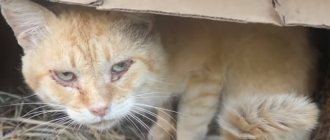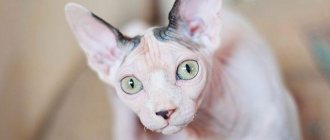Representatives of this breed, like other furry pets, regardless of gender and age, can be charming, playful and playful.
Here useful information will be provided on how to organize food, how to take care of the fur, how to care for it in case of illness, and other things that those who have chosen a Siberian blue cat as a pet need to know.
This information will be useful and interesting to those who adore cats and want to purchase or adopt a representative of this breed into their home. However, you need to know that the cost of these beauties is usually quite high, due to the unique features of the breed, however, there are exceptions.
Appearance and breed standards
The Siberian cat is an amazing breed of cat that has Asian roots.
Not so long ago it was believed that these animals were of Russian origin, but such an opinion was erroneous and was very quickly refuted. Indeed, the place of origin of these wonderful animals is considered to be “Russian” Siberia. However, only starting from the 16th century, Siberia joined Russia. Until this time, Rus' was not engaged in conquering lands, but in wars with the Tatars. The first information about Siberian cats is found much earlier.
The ancestors of Siberians are wild cats that lived in the lands of the Trans-Urals. There are several hypotheses regarding the exact origin of the breed. One of them is that the Siberian cat appeared as a result of crossing a wild cat and a representative of a domesticated species.
Another theory adheres to the version that Siberians are purely representatives of a wild steppe breed. The creation of which was purely nature's work.
Important: thus, despite all the nuances, you can be absolutely sure that wild blood flows in the veins of Siberian cats. This fact, of course, affected not only the habits of the animal, but also its character, as well as its attitude towards its relatives and owner.
The Siberian cat has a wide variety of color types. Thus, the potential owner will have absolutely no problems choosing the color he likes most:
- blue;
- red or golden;
- black;
- Nevskaya;
- white;
- forest;
- tortoiseshell;
- gray;
- other.
Important: there are also rarer colors of Siberian cats. However, they are extremely difficult to find from breeders, since official breeding welcomes a purely classic version of the breed.
The breed characteristics of this cat are surprising. They have a muscular body structure, a wide chest, a large head, and their limbs look powerful due to their fur and bone structure. The elastic belly area and strong neck give it an advantage over other breeds.
The back seems a little higher because... the shoulder corset is slightly lowered down. The shape of the ears is acute-angled with tassels on the tops. They have a slight slope. Long, beautiful and fluffy, as if with a fringe, the tail is slightly lowered down, but does not touch the ground. The eye shape is round.
Watch the TV show “Zoo Academy”, where the authors and guests will tell you about their Siberian pets. The guests, who are also the owners, have a very interesting Siberian color!
It is generally accepted that their eye color is yellow. But depending on DNA and ancestry, the color may vary. The muzzle has massive cheekbones, a wide forehead, and is slightly elongated. A wool collar may be present on the neck. The cat's entire body is covered with long hair with undercoat to prevent the ingress of water and dirt.
The weight of these males of this breed reaches 10 kilograms! Girls weigh half as much. They are considered one of the large breeds. Only the Norwegian Maine Coon can compete with them.
The first and most interesting color we will look at is “Neva Masquerade”. Long-haired cat with a color-point color. Contains colors of gray-blue, brown-white, somewhat similar to the Siamese, only with long hair.
Nevskaya Masquerade
This breed is indigenous, that is, formed practically without directed human intervention. The Siberian cat appeared a very long time ago, so it is not possible to determine exactly where the first animals were brought from. At the same time, immediately after gaining worldwide fame, this cat breed acquired many myths and legends.
The characteristic “forest” appearance of cats appeared under the influence of weather conditions, namely severe frosts, which are not uncommon in Siberia. They have little in common with wild representatives of this family. Professional felinologists note that until the 16th century there were no these domestic animals in this area. Most likely, the first cats were brought in at the end of the 17th - beginning of the 18th century. It is still unknown where the ancestors of modern “Siberians” came from.
It is believed that at first the animals did not have thick hair, so they were not adapted to the climate of the region. That is why the Russian Siberian cat quickly acquired its characteristic thick coat, which protects even from severe frosts.
Since researchers became interested in Siberia at the beginning of the 18th century, it is believed that the formation of the breed could have been influenced by cats later imported from Europe, as well as by the “Persians” who got there through the Silk Road. With the infusion of new blood, local Siberian animals took on the best characteristics.
In the post-war years, these animals were actively exported to the largest centers, as they are excellent hunters of rats and mice. Only in the 50s did active breeding work begin, which was aimed at polishing the characteristics of representatives of this breed. The first standard was adopted in 1987.
Since the life of these creatures was by no means easy for a long time, the new variety of cats that emerged is distinguished by excellent health. Excellent immunity and the absence of genetic diseases set these animals apart from other breeds. How many years such a cat lives depends on many factors, including the characteristics of its maintenance.
The first thing that distinguishes the Siberian cat from other domesticated representatives of the family is its size. This is a very important characteristic of the breed. The average weight of adult cats is about 5–8 kg. However, some representatives can reach very large sizes without harm to health. The weight of such giants can reach 12 kg and more.
When it comes to an animal such as a Siberian cat, the breed standards approved at the end of the 20th century remain relevant today. These creatures are distinguished by a large muscular body with developed bones. The body is of medium length and proportional. The muscle mass of an animal is formed up to 3 years. Before purchasing a kitten, you must carefully study the description of the breed.
Because of this, the animal's back looks slightly sloping. This structure adds speed and agility to the animal, so cats are able to catch not only rats and mice, but also small rabbits. The paws of “Siberians” are very large and muscular. Since this breed appeared in severe frost conditions, even between the toes there is thick hair that protects against frostbite.
The eyes are oval in shape, medium in size and slightly slanted. The iris can be any shade of green and yellow. Like few other types of purebred animals, the Siberian cat can have a very different color. The varieties of colors and shades and their combinations are difficult to describe. In fact, according to the standard, the colors of Siberian cats can be almost any color. The most common color is smoky. The exceptions are the following colors:
- point;
- lilac;
- Abyssinian;
- Brumesian.
White cats with brown and red color points are now distinguished as a separate breed, which is called the Neva Masquerade. The patterns of these animals can be varied. Recently, the Siberian blue cat and other representatives of the breed, distinguished by their uniform color, have been especially valued by breeders.
Buying an animal with a long pedigree is currently extremely problematic. This is due to the fact that these cats were registered as a separate breed relatively recently. If you want to buy a kitten to be an ordinary pet, you can contact private breeders. In this case, the animal will cost an order of magnitude cheaper, but documents confirming the pedigree will be difficult to obtain. However, even in this case, you need to pay attention to what the kitten looks like and what its behavior is. Very important:
- compliance;
- cleanliness of fur, ears and nose;
- presence of shine in the eyes;
- curiosity about surrounding objects;
- playfulness;
- activity.
A Siberian cat must be in excellent health. It is very important to make sure that kittens have received all necessary vaccinations. All this will allow you to avoid buying an ordinary yard animal. If it is assumed that a cat of the Siberian breed will subsequently participate in exhibitions and breeding work, the animal should be purchased from a special nursery where the standards comply with WCF.
Typically, such institutions carefully monitor the future fate of their “graduates,” so their employees can tell everything not only about the kitten, but also about the character of its parents. In addition, in this case, a lot of recommendations are given for the care and maintenance of the animal. Typically, the recommended age for weaning from a cat is 1.5–3 months. At this time, the pet still has features that distinguish it from its parents, but at the same time the main characteristics of the breed should be clearly manifested in it.
We suggest you read: Treatment of scabies mites in cats
These animals have an excellent hunting instinct. A Siberian cat can easily catch a mouse, although outwardly it looks extremely clumsy. People living in private homes note that such a pet often brings its prey to its owners to “please” them. These creatures are completely fearless. Some of them zealously guard their territory, warning their owners in advance about the appearance of strangers.
Siberian blue
Thus, through the efforts of our and English felinologists, not only Siberian beauties with long hair were obtained, but also with short hair (see photos of Siberian cats of the standard breed).
Siberian fur does not cause allergies, so people suffering from this scourge can afford them.
Character and life with people
Some owners cannot be happier that their pet lives a long and happy life. For others, pets do not live to a ripe old age. What is the reason for this difference? A number of factors can greatly undermine the health of your beloved pet. It is important for the owner to know about them in order to prevent their occurrence.
- Genetic predisposition. Every cat breed is susceptible to some disease to one degree or another. For example, Persian cats are susceptible to kidney disease, which sooner or later leads to kidney failure. Therefore, Persian cats live on average about 10 years.
- Habitat. It's no secret that indoor cats have a better life than outdoor cats. Pets are surrounded by care and love, protected from viral and bacterial attacks, infections and other misfortunes that await a pet on the street.
- Nutritional features. How long British cats and other breeds live depends on their diet and balance. A lack of vitamins and minerals can cause damage to health, sometimes irreparable. You should consult your veterinarian when choosing food. However, there are doctors who can recommend dry and wet commercial food; There are experts who are categorically against such a diet. They stand for natural food.
- Sterilization. Few people know how long unsterilized pets and cats live after sterilization. Again the camp was divided into two fronts. The first doctors believe that sterilization prolongs the life of the animal due to the fact that the pet will not be susceptible to diseases of the genital area. Sterilized cats live several years longer than their counterparts. On average, sterilized individuals live about 15-20 years. Cats that give birth regularly shorten their lives. Other doctors believe that sterilization leads to lethargy and inactivity of the animal. This, in turn, leads to diabetes, obesity and shortened life.
- Predisposition to chronic diseases. If a pet has a chronic disease or a disease that is inherited, then it is unlikely to live to a ripe old age. So, a cat with diabetes lives only 4 years. An animal with urolithiasis can live only 5 years.
- Stress. Do you know how many years do pet cats live in a family where an optimal psychological climate is maintained? Add a couple of years to the average. Such pets are real long-livers.
Animals for whom the street is their father's home will live at most 5-6 years. Survival without water or food affects how long outdoor cats live. The body of such a cat literally fights for every opportunity to survive.
But how long domestic cats of common breeds live is shown in the table. The average lifespan of any domestic cat is approximately 12-17 years. But there are cases when representatives of the cat family crossed the threshold of 20 years.
How long a pet will live is influenced by its predisposition to various diseases. Every owner strives to do everything so that his pet lives as long as possible. However, at an advanced age, felines can develop diseases that were not so common before. Such ailments include chronic renal failure.
Today, approximately 30% of cats suffer from kidney failure. About 20 years ago, this disease occurred only in a few, but now it affects more and more pets. Chronic renal failure is a disease that doctors cannot yet cope with. Veterinarians are not yet able to restore health to a pet and make its life fulfilling.
If previously cats died at the age of 10-13 years, then in the modern world, on average, domestic cats live about 18-23 years. Such pets are considered long-livers in the animal world. However, longevity also has a flip side to the coin. An increase in the number of pets developing kidney failure is associated with an improvement in the quality of life and its duration.
How long cats can live at home with kidney failure depends on how badly the kidneys are damaged. The larger the affected area, the more difficult it is to cure the disease. If the owner did not notice a deterioration in health in time, and the pet was taken to the veterinarian with an advanced disease, then most likely the pet will die a month after the disease was discovered.
Timely identification of symptoms and compliance with doctor’s instructions can prolong the life of a cat with renal failure (in chronic form) to the average life expectancy: 10-13 years.
It turns out that this disease is more common in cats of a certain breed, for example, British or Persian. This is due to their predisposition to a congenital anomaly - polycystic kidney disease. This, in turn, leads to kidney failure.
As a preventive measure, doctors recommend periodically showing pets to veterinarians and doing clinical and biochemical blood tests: creatinine, urea, protein, potassium, phosphorus. You also cannot do without a general urine test. Thanks to laboratory tests, the veterinarian will be able to track the failure of the cat’s kidneys and prescribe supportive therapy.
Thus, it is best to get a couple of unrelated pets at once. In some cases, these animals form exclusively monogamous relationships. The character of Siberian cats is also manifested in their restraint towards people: the pet usually appears when the owner is in a good mood in order to play or just scratch behind the ear.
Usually cats understand children very well and tolerate their pranks without complaint. Some people who have kept representatives of the Siberian breed for a long time note that the animals have a powerful biofield. Such pets can cure various diseases. In particular, there is an improvement in the condition of neuralgia, osteochondrosis and rheumatism.
The average lifespan of a Siberian cat is 13 to 20 years.
However, these figures are influenced by a fairly large number of factors, namely:
- food quality;
- quality of care;
- availability of self-walking;
- vaccination;
- sterilization or castration.
Important: during castration and sterilization, the animal gets rid of many instinctive processes that affect the quality and duration of life - reproduction, childbirth, feeding of offspring. On average, after such operations, the animal lives 5-7 years longer.
The Siberian cat has a rather specific character, but this is not difficult if you find a common language with your pet and make friends. Considering the wild nature of the ancestors of the Siberian cat, the animal is freedom-loving, active and self-sufficient.
However, the genes that the Siberian inherited from the domestic cat also have an effect here, which turns a skilled hunter into an affectionate, flexible and gentle pet.
It should be noted that the character of the Siberian breed is a real mix, which every time pleases you with something new. These animals are wonderful friends and companions, they sincerely and truly become attached to humans. They are not against active games and scratching.
However, this animal must be provided with sufficient space so that it can be alone with itself. Make sure your pet has enough toys so that your new sofa or wallpaper doesn't get used.
How long do cats live and how to extend the life of your pet? The life expectancy of cats is influenced by various...
We suggest you read: What kind of stool should a cat have?
Being active, a long-haired cat does not need excessive attention from the owner. In a family, a cat chooses a favorite and becomes attached to it. The affectionate and friendly Siberian does not like sharp and loud noises, to which she will react with a hiss if the sound is heard nearby.
The character of Siberian cats is brave and determined. In common parlance they are called watchdogs. If you look closely, in some photos they look like German shepherds. There have even been cases when cats of this breed attacked street dogs that entered their territory.
How long do Siberian cats live in a house or apartment, in our Siberian region and its climatic conditions? The breed makes us happy with these indicators. They live longer than other breeds. Even though this figure hasn’t gone up much, it’s still nice.
On average, a Siberian cat lives up to 15 years. It is unknown how many years your pet has. Everything is determined by external factors and care. Timely sterilization and castration will bring many happy years of life.
It is difficult to say to what age Siberians grow. There are different colors and breeds of Siberian cats. Some grow up to a year, others are fully formed over several years.
Nutrition plays an important role in life expectancy. Specialized food, according to experts, prolongs life, unlike cats that eat anywhere and anything. The longer the kitten eats mother's milk, the better for it. It contains all the strength and nutritional elements.
Heredity and genes influence how many years a kitty will live. Diseases, health, and many other factors affecting life are transmitted from ancestors along the line. But there are also individuals who live 20 years or longer, but this is rare.
How long do Siberian cats live in the harsh conditions of apartment living? They may get injured or poisoned. Contact your veterinarian promptly for help if something happens to your pet. Do not delay under any circumstances.
Kitten weight by month
In a litter of Syrians there can be up to 9 cubs, reproductive age lasts up to 18 years.
- A Siberian kitten is born weighing approximately 100 grams.
- At 2 months, a kitten should weigh 2-3 kilograms.
- At 5-6 months, Siberians can reach 4-6 kg.
- By the age of one year, a kitten’s weight can reach 5-7 kg, the same as an adult’s weight. Cats can weigh up to 12 kg.
The size and weight of Siberian little kittens always exceeds the dimensions of an ordinary cat. Weight largely depends on the diet of the animal. All babies are individuals and develop at their own pace.
How long do Siberian cats live?
Many factors influence the lifespan of pets. The first is heredity. Since the ancestor of Siberians was the Bukhara cat breed, they received strong immunity, plus, as a result of natural selection in harsh conditions, Siberians acquired additional endurance and resistance to disease.
On average, a Siberian cat lives 15-17 years, but long-livers are often found; they bring joy to their owner for more than 20 years.
The main thing is to seek help from a specialist in a timely manner, and not to treat your pet on your own and monitor its behavior. If a previously active cat suddenly refuses to play or eat, this is an alarming sign; do not delay visiting the veterinary clinic.
Description
If you look at any photo that shows a Siberian cat or kitten, you get the impression that this is a big fluffy ball that can lazily lie on the window all day long and do nothing.
The first impression in this case will be extremely misleading, since the Siberian breed is a real predator that does not sit still for a minute.
Siberians are extremely active and mobile animals. Their well-developed muscles allow them to jump high and run fast. They can not get tired for a long time and almost never give up outdoor games. Beautiful, thick and shiny fur makes these animals incredibly attractive in appearance.
The Siberian and Persian cat breeds have many common features, but this does not make these animal species “related” at all. On the contrary, it is considered a big mistake when unscrupulous breeders use Persians for crossing to obtain new, non-standard colors.
Where to buy a Siberian kitten?
You can buy Siberian kittens at a nursery or from a breeder. The cost of a kitten is influenced by many factors (pedigree, color and other features). The lowest price for a purebred Siberian cat will be about 5 thousand rubles (1,200 UAH), the maximum cost can reach 20 thousand rubles (8,000 UAH).
Where to buy a Siberian kitten? We invite you to pay attention to the following nurseries, the reviews of which are only positive:
- Cattery of Siberian cats “Dauria” (https://www.dauriacats.ru/about.html) and nursery “Gloria” in Russia, Moscow.
- Nursery “Girasole” (https://girasole.by) in Belarus, Minsk.
- Nursery “Zaimka” (https://zaimka.com.ua/) in Kyiv.
Choose a fluffy kitten from any nursery or breeder and you will not regret having a Siberian cat as your friend.
Peculiarities
The Siberian is not just a breed, it is a whole set of the most unimaginable feline qualities that one could wish for in the most ideal cat.
So, this breed can boast of the following merits:
- excellent hunter (this breed is perfect for keeping in a private home);
- despite the fluffy fur, it requires almost no care, since Siberian cats are incredibly clean;
- do not provoke allergies in humans;
- handsome;
- smart.
Important: an interesting characteristic of the Siberian cat is that they are incredibly vulnerable and touchy. This breed does not always readily get along with new pets. Thus, for a long time the pet is able to ignore the owner and refuse water and food.
Temperament of the Siberian Blue
This breed has a freedom-loving character and a very pronounced sense of self-importance. She does not pester people in search of affection and allows herself to be petted only in a good mood.
From her distant ancestors she retained a strongly manifested hunting instinct. They are capable of catching not only small rodents; rabbits and ferrets sometimes become their prey. However, these furry predators are quite good-natured and friendly with humans.
Appearance and breed standards
The characteristic features of the Siberian cat include not only its habits. The description assumes the presence of characteristics of behavior and appearance.
| Weight | Ranges from 6 to 12 kg |
| Body | Muscular and heavy. The animal has a wide and dense neck. The paws are well developed, with wool tassels between the toes. |
| Head | Short, wide, with low-set cheekbones. The muzzle and chin are rounded, the forehead is convex. The contours are smooth and harmonious, gradually turning into profile. |
| Ears | They are of medium size. The tips are slightly rounded, wide at the base. |
| Wool | Thick, soft, shiny with dense undercoat. The tail is fluffy, rounded at the tip. Particularly thick hair is found on the neck, chest, hind legs and tail. The most common coat colors: red, black, blue, forest. |
| Eyes | Wide, big. Set wide apart. Eye color can be very diverse, but it must be in harmony with the color of the coat. |
Forest cat
The Siberian forest cat looks massive. The weight of adult individuals is up to 12 kilograms. It has a great advantage over other types. She has long, thick fur and a dense undercoat. The undercoat tends to thicken seasonally when cold weather sets in. Wool is waterproof and comes in different colors.
This breed is famous for its loyalty, intelligence and independence. He is not afraid to swim in the water, he can even play with toys in it. Her massiveness does not limit her movement. Easily climbs onto high surfaces in the apartment. Every day this rare breed is becoming more and more popular among cat breeders.
Conditions of keeping and care of the Siberian cat
Representatives of this breed are not whimsical, so they can live both in an apartment and in a private house. However, you need to take into account that the Siberian cat loves long walks and freedom. Animals are smart, so they can quickly learn to find their way back on their own, even in an apartment building. Walking is also necessary in winter.
These cats at home quickly get used to the litter box, but they prefer to relieve themselves outside, so it is quite possible to train your pet to go into the yard when the need arises. Despite the fact that all domesticated representatives of this family are clean, you need to know how to care for a Siberian cat.
- slicker;
- mud comb;
- wide flat brush;
- rough massage glove;
- a piece of suede.
If you have a Siberian cat, caring for it should be comprehensive. You should periodically check your ears for dirt. If necessary, the ears should be wiped with an oil swab. Caring for a Siberian cat also involves providing the animal with a special scratching post. This will prevent damage to the furniture. Among other things, you need to organize a play corner for such an active pet.
If a cat periodically goes outside, where he can come into contact with other animals, it is necessary to carry out treatment for fleas and worms.
Caring for Siberian cats is not as difficult as it might seem at first glance. If you pay enough attention to your pet just a few times a week, then no problems with its coat, teeth and other components of the health and beauty of this breed will arise.
Nutrition
The owners do not have any particular difficulties when feeding and selecting a diet for Siberians. The thing is that these cats are adapted to a wide variety of foods. Thus, selecting feed will not be difficult.
Important: when feeding kittens of this breed, it is worth considering the amount of protein they need. The muscles of Siberians are formed up to 3 years, and during all these 3 years the predominant element of nutrition for a cat of this breed should be proteins - 70%.
The diet of a Siberian cat should contain the following nutrients:
- meat;
- fermented milk products;
- quail eggs;
- goat milk;
- boiled fish;
Veterinarians recommend introducing vitamins into the diet that maintain the condition of the coat, its color and thickness. Usually these are dry mixtures and special foods.
Grooming
Despite the fact that Siberians have fairly long hair, there are practically no problems with caring for it. The cat's coat is thick and strong, and tangles occur very rarely.
Even though the breed's coat does not tend to come out in clumps during shedding, caring for it is very important. It is worth considering that most of the dead hair that remains on the animal’s body ends up in its stomach.
We suggest you read: Proper training of British cats
In order to save your pet from the suffering that often arises from swallowing fur, it is necessary to comb out all excess undercoat in a timely manner.
Important: to make it easier for your pet to deal with hair that gets into the stomach, you can add fresh grass or oats to its diet.
This breed needs to be taught to bathe from childhood; kittens adapt much more easily. The frequency of water procedures should not be excessive; one bath every 8-10 months is enough.
Also, veterinarians recommend that you provide your animal with a scratching post.
Caring for a Siberian cat is not a problem for owners. When the shedding period begins, so little hair falls out that it cannot roll into a ball. You can quickly collect all this with a regular cat comb. The Furminator will be your ideal assistant.
Furminator for wool
To prevent your pet from swallowing its own fur and getting an intestinal infection, it is necessary to supplement the diet with oats and natural grass. The care and maintenance of this breed will have a positive effect on the atmosphere in the house. After all, bathing a cat is such fun! They don't really like water. They prefer to wash themselves.
But if you get used to water from an early age, you will avoid bloody consequences in the form of scratches and bites. Be sure to purchase a scratching post; if the claws are very sharp, it is advisable to trim them. Now you know how to care for a Siberian cat. If you have any questions, ask them in the comments!
Care instructions
Do not let your Siberian cat bask in the sun for a long time: from the bright sun, its fur begins to fade and may change color.
Wool
The calling card of the “Siberian” is its thick and long coat. It is necessary to comb the animal 2-3 times a week, during the molting period - daily, first using a wide-toothed comb, and then a slicker brush.
Bathing
“Siberians” are bathed only when their fur gets dirty: they don’t like water. The exception is an exhibition, before which a general polish is put in place.
Shampoos are selected that are special, do not dry out the coat and skin, and contain antibacterial additives. For example, “Detangling Celandine” Ecoprom, Doctor ZOO for long-haired cats, Phytoelite “From tangles”, AVZ Elite Professional.
Claws
The cat's claws are trimmed once a month: no more than a third, and without touching living tissue. The rest of the time, the animal copes on its own, grinding them off on a scratching post.
Ears
Check your ears every week. Accumulations of sulfur and dirt are removed with a cotton swab dipped in lotion (Api-San “Rosinka”) or chamomile decoction. The eyes of Siberians do not require special care.
Teeth
Once a week, be sure to brush your cat's teeth using a special short-bristled brush and cat toothpaste. If the animal refuses to be cleaned, scratches or becomes very frightened, use alternative means: liquid gel (dropped into water) or cleaning pads.
In the photo there are kittens of the Siberian breed
Health
The Russian Siberian cat has good health indicators. But you can't resist genes. A kitten, even at birth, can get a heart defect. Which has an adverse effect on his future life. But proper care and proper education will help you live a healthy life. But this is a rare case.
When all is well, it is necessary to follow the vaccination list, regularly visit the veterinarian, undergo a parasitic program, clean the ears and, if possible, teeth. To do this, you can buy something at a pet store.
If you live in the private sector, then do not be afraid to let this creature out into the street. They adapt very well to Siberian frosts, because they are originally Siberians. Moreover, walks are even recommended for them for good and good health.
The cat breed is considered to be hypoallergenic. Therefore, it will not harm your baby. But you need to bathe her with a special shampoo. The playground will become a cozy place for your pet to spend time. Don't forget to change the litter tray regularly to prevent your cat from getting an infection.
Vaccination
Siberians, like other animals, need vaccination, deworming and other preventive procedures.
The first vaccinations for cats are given at an early age. Pets are usually vaccinated against the following diseases:
- feline leukemia;
- plague;
- panleukopenia;
- viral rhinotracheitis;
- infectious peritonitis.
All of the above vaccines are given to absolutely all kittens, which does not depend on their breed.
Experts recommend focusing on those vaccines that are imported. Their quality has been tested for decades, and cats usually tolerate them much better.
Important: when is the best time to get the first vaccination? This is a rather complicated question. Even doctors often contradict each other on this issue. The golden mean is still considered to be 2-3 months of age. Revaccination is carried out after 3 weeks.
Information about your pet's vaccination must be included in the veterinary passport. Do not forget that vaccination is required only when the kitten is completely healthy, alert and pre-wormed (about 10-14 days before vaccination).
Nutrition
Be sure to have a separate place to eat. It is advisable to place a bedding under the bowl. Food in one bowl, water and milk in another. Plastic or metal bowls - it's up to you. Wash bowls regularly after emptying them.
If your pet is not even three months old, then it is better to feed him 5-6 times a day in small portions. After three months, begin to observe and give food when the bowl is empty or upon request. An adult cat can be fed a couple of times a day, for example, in the morning and before bed.
But what to feed your Siberian cat is up to you to choose based on its body characteristics. The main thing is not to feed the same food all the time. Periodically you can feed with egg yolk, fermented milk products, sour cream, finely chopped raw chicken, and fresh fish. Try giving some vegetables.
What factors influence the lifespan of domestic cats?
- According to many breeders, Siberian cats are the best mouse and rat catchers in the world, among other breeds. Even in a dream, a pet can hear the rustling of a rodent and immediately go hunting.
- Siberians are considered the only breed in Russia whose creation was created more by nature than by man.
- When people see fluffy cats, they want to touch their fur and cuddle the owner of such a fur coat. But this trick doesn’t work with Siberian cats.
- These cats know their worth and will never allow themselves to be treated disrespectfully and obscenely, especially by strangers.
- Siberian cats are endowed by nature with many qualities. They are graceful, very dexterous and tirelessly gentle towards their humans. With proper care and honest upbringing of the pet, the owner can achieve mutual respect with his pet and spend many happy hours, days and years with him.
History of the origin of the breed
The first mention of unusual animals similar to Siberians appeared in the 16th century, it was the Bukhara cat. In the Volga region this name is still preserved. Further information appeared in the 18th century. They told about a large, fluffy and very expensive cat, brought to Russia by merchants along the Silk Road.
Information about where this graceful hunter came from in Siberia is not known; people with their pets came to explore the taiga from all over the world. According to one version, her homeland is Bukhara. However, the imported cats assimilated, crossed with forest and steppe cats, and acquired an even more luxurious coat. Thanks to its wild ancestor, the cat gained excellent endurance and strength.
The Siberian cat breed is aboriginal, a real source of pride for Russian felinologists; it has its long hair and independent character thanks to nature itself. Large wild cats of Siberia with a developed hunting instinct have long been valued and exported to various countries to catch mice.
The breeders only had to slightly improve the natural gene pool by crossing with oriental breeds and receive a certificate. The first to introduce the new breed of Siberians was the cat Roman in 1987. The history of the origin of the breed is similar to the legends about Maine Coons and Norwegian forest cats.
Mating
Before mating, the cat must be thoroughly prepared. To do this, you need to carry out all the most necessary vaccinations and deworm the animal for preventive purposes.
Selecting a gentleman for a cat is also a rather painstaking process. An ideal partner would only be a cat of a similar breed. This will prevent mixing of blood and the purity of the breed will be preserved. Before mating, you need to make sure that there are no other breeds in the partner’s pedigree.
Important: categorically do not agree if you are offered a supposedly short-haired Siberian or fold-eared cat for mating, since Siberians are only long-haired and have straight ears.
Mating takes place in the gentleman's home. This will not scare the cat away, as he will be in a comfortable atmosphere. Having entered the house with a carrier in which the cat is already located, you need to quickly take it out and leave, leaving the couple alone.
Important: mating requires a fairly long period of time. You shouldn’t expect everything to happen after 2-3 hours. Typically, cats require 20-24 hours. Therefore, it is better to leave the cat with the cat for 1-2 days.
There is often a situation when a cat flatly does not allow the cat to approach her. In such a situation, they need to be left in the same room so that the animals can catch each other's smells.
Cost and the right choice
If you want to purchase a purebred and healthy Siberian kitten, then prepare to pay from 6 to 10 thousand rubles for it. The cost per animal may vary, taking into account the popularity of the nursery where you are planning to purchase a pet, as well as the title of the baby’s parents.
When directly choosing a pet, be sure to pay attention to the following points:
- Age - must be at least 2.5 months.
- Condition of the coat: there should be no sticky fibers or dull color.
- Condition of eyes and ears - there should be no dirt or discharge.
- Vaccination - at the time of giving the kitten, he must have received at least 1 vaccination.
Siberian cats are an easy-going and not overly demanding breed. Such pets are suitable for families where there are older children, but not small ones, since during the game the cat may not calculate its strength.
Despite their independent nature, these animals are very kind to humans and will never allow their owner to be disappointed in them.
Color
The fur of pets is fascinating and deserves special attention. Its texture can be either soft or hard, depending on the color. Some individuals have a curly coat on their tummy and “pants,” but this is not important for the breed; in this case, genetics played a role.
Siberian cat photos
According to established color standards, a Siberian cat should not be:
- fauns;
- lemon;
- "burma";
- cinnamon color (cinnamon).
These same colors are not allowed in combination with white.
Individuals can be either monochromatic or with different patterns; their variety is great and elegant - beautiful.
Allowed colors:
- chinchilla;
- “turtle” - three-color color;
- stripes - brindle (different colors in combination with white);
- colorpoint;
- gold;
- silver;
- pure white;
- grey;
- tabby;
- black and white;
- cream;
- blue;
- smoky.
Interesting! Siberian cat kittens can inherit any color from their parents, but it is curious that the cat will be the same color as “mother,” and the female cat will take the color from both parents.
Nature was truly generous to the species and endowed them with a wonderful palette of colors.











